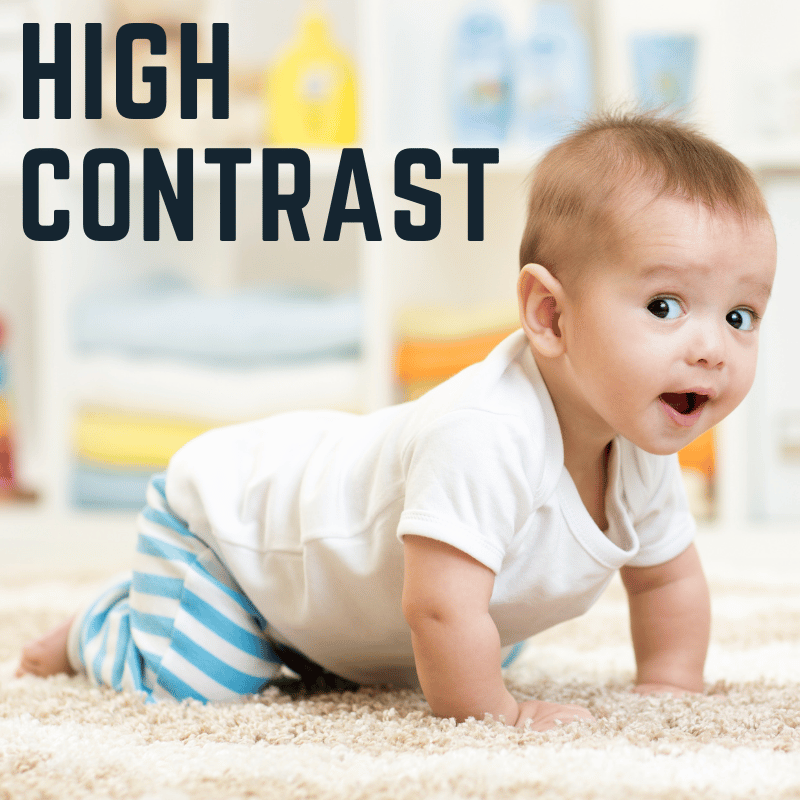
How Babies Perceive Colors and Shapes at Different Stages of Development
A baby’s vision develops rapidly in the first year of life, transitioning from blurry, black-and-white perception to a full spectrum of colors and well-defined shapes. Understanding which colors and shapes are most engaging at each stage can help parents provide the right visual stimulation to support their child's growth.
Stage 1 - Newborns (0-3 Months): Seeing in High Contrast
- Colors: At birth, babies have limited color perception and can mostly see in shades of black, white, and gray. Their eyes are still developing the ability to process light and focus on objects.
- Shapes: Babies respond best to bold, high-contrast patterns, especially simple geometric shapes like circles, stripes, and checkerboards. These patterns help strengthen their visual pathways and improve eye coordination.
- Check out Hammer & Rattle’s High-Contrast Apparel, allowing little ones to engage with stimulating visuals while being close to their caregiver.
Stage 2 - Infants (3-6 Months): Discovering Primary Colors
- Colors: By 3 to 4 months, babies begin to perceive some primary colors—red, blue, and yellow—as their color receptors (cones) in the eyes develop. Red and yellow are often the first color they can recognize clearly.
- Shapes: Babies can now track larger, high-contrast objects moving across their field of vision. They start distinguishing between basic shapes like squares, circles, and triangles.
Stage 3 - Older Infants (6-9 Months): Recognizing More Colors and Complex Shapes
- Colors: By 6 months, babies can see a wider range of colors, including softer pastels and secondary colors (green, orange, and purple). Their depth perception is also improving.
- Shapes: At this stage, they begin recognizing more complex shapes and patterns. They also enjoy visual textures, such as polka dots and zigzags.
Stage 4 - Toddlers (9-12 Months+): Understanding Color Differences and Object Recognition
-
Colors: Near adult-like color vision and much improved acuity. Tracks fast motion;
judges distances for small objects. Beginning of symbolic understanding
(recognizes pictures, simple words). Their ability to recognize and name colors will continue to develop into early childhood. - Shapes: Babies can now identify familiar objects and shapes, like animals, faces, and household items. Their hand-eye coordination improves, allowing them to interact more with shape puzzles and toys.
Stage 5 - Toddlers (12-18 Months+): Excellent Detail and Motion Tracking
- Colors: Use bold color contrast to emphasize new concepts such as letters and shapes
-
Shapes: Toddlers can now identify more complex patterns and images are
fine, but use contrast to make features distinct (helps in sorting, matching)
How to Support Your Baby’s Visual Development
- Stage 1: 0-3 Months: Use high-contrast patterns in clothing, nursery décor, and toys to stimulate their early vision.
- Stage 2: 3-6 Months: Introduce bright red, blue, and yellow items with simple shapes.
- Stage 3: 6-9 Months: Provide a variety of colors in their surroundings and add in colors like green and purple to encourage exploration.
- Stage 4: 9-12 Months: Encourage color and shape recognition with more complex shapes, colors, and scenery.
- Stage 5: 12-18 months+: Encourage new elements and learning names for letters, objects and actions.
Final Thoughts
A baby’s vision development is an exciting journey that unfolds over time. By using high-contrast visuals, bold primary colors, and engaging shapes, parents can help strengthen their baby’s cognitive and sensory skills while making everyday interactions more stimulating and fun!
Explore our collection of high-contrast apparel and accessories for little ones at Hammer & Rattle.